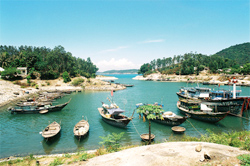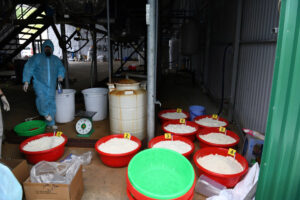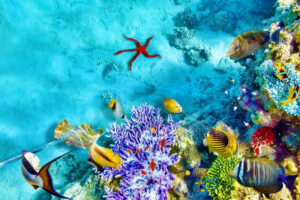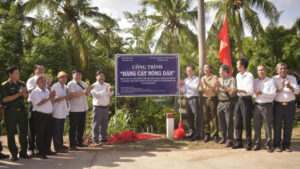With pristine white-sand beaches surrounded by azure water, Quang Nam Province’s Cham Island is renowned for both its legendary beauty and vast biodiversity. Situated 25 nautical miles off the coast of central Quang Nam Province’s Hoi An Town, Cham Island (commonly known in Vietnamese as Cu Lao Cham) actually consists of seven islets named according to their shapes and characteristics.
Individually, they are known as the Lao (pear), Dai (long), La (leaf), Kho (dry), Tai (ear), Mo (tomb), and Nom (east wind) islands.
The scenic landscape is ideal for camping, swimming and scuba diving with a stunning array of coral and marine life.
Taking a boat is the only way to access the islands. Visitors can take a leisurely cruise in a wooden boat offered by local tourism companies, which takes about an hour and a half, or travel by speedboat, which takes just 25 minutes.
Once on the islands, there is a host of activities waiting to be discovered. On Lao Island, the largest of the island group, tourists can take a ride in a glass-bottom boat to view a white coral reef along Bai Xep Beach.
Visitors here can also observe sea-swallow nests, which sit precariously amongst the island’s towering cliffs, or visit a temple built to honor the ancient peoples who first discovered the birds’ nests.
Islanders harvest up to 1.4 tons of the sea-swallow nests each year, which sell for around US$4,000 per kilo.
A typical island tour also includes a visit to a small bay where local fishing boats take shelter during storms or other natural disasters. The area was constructed after a typhoon in 1989.
There is also the ancient, eye-catching Hai Tang Pagoda, built in 1758 on the western hillside of Lao Island. An elderly Buddhist woman who offers each tourist a cup of herbal tea enhances the tranquil area.
At Bai Chong Beach, arguably the most gorgeous beach on the island, visitors can truly indulge each of their senses.
One can listen to the sounds of the gentle wind and the waves crashing onto the shore, breathe in the fresh sea air, gaze out at the crystal-clear water, touch the smooth white sand, and sample the local cuisine.
After taking a leisurely nap in a hammock, tourists can paddle a canoe along the coast, go snorkeling, or take a short trek to visit a local fishing village. Tourists are also welcome to enter the small village, known as Bai Huong, and meet with the local fisher people to learn about the trade.
In the evening, visitors can camp out in tents under the stars for a spectacular view of the night skies.
“Happy and happy!” exclaimed Sumalini, an Indian college professor, as she left the island after spending the night.
Underwater wonders
Cham Island is also a terrific place for tourists wanting to explore the magical sights beneath the water. Here, an underwater world of brilliant coral, fish, and other sea life is waiting to be discovered.
For those wanting to advance their knowledge, PADI Open Water
Dive courses are offered. Students spend three to four days learning the fundamentals of scuba diving, including equipment and techniques, as well as completing four open water dives.
“Having just gone diving in both Australia’s Ningaloo Reef and the Great Barrier Reef last month, I can honestly say that some of the diving off of Cham Island is world-class,” said an American tourist from New York City.
“The entire Cham Island dive team was incredibly enthusiastic and unbelievably helpful during our time with them,” he added.
“The diving was fantastic and the team was great,” echoed another tourist from the UK.
A global biosphere reserve
The seven-island cluster boasts another glowing attribute – UNESCO recognition as a global biosphere reserve.
The United Nations Educational, Scientific and Cultural Organization (UNESCO) made the announcement in late May that Cham Island would receive the special designation.
The islands, which are governed by Hoi An, also serve as a protective barrier for the ancient town.
Lecturer Hans Dilev of the Danish Aarhus University said Cham Island is one of the few places in Vietnam that still possesses a large area of vegetation and a wide range of rare and endangered animals.
The islets are located near the Bach Ma-Hai Van-Son Tra granite mountain range, formed around 230 million years ago. In 2004, Vietnam named the island area a national “sea reserve” – one of just two island reserves in the country at the time. The other was the Mun Islet reserve in Khanh Hoa Province.
Spanning more than 5,000 hectares, the reserve includes 165 hectares of coral reefs and 500 hectares of underwater plant life. They are also home to some 947 aquatic species.
The vast biological diversity can also be seen in the Cham Island mountains, which stretch over 1,550 hectares.
Within the immense island forests are many rare animal species, including the endangered long-tailed monkey and swallow. And of the hundreds of flora species in the area, more than 60 percent are used by locals.
Hoi An residents have worked hard over the years to attract more tourists by keeping the islands clean, and their efforts have paid off. Some 20,000 tourists now visit the area each year.
With the recognition of Cham Island, Vietnam’s number of global biosphere reserves now stands at eight.
UNESCO grants “world biosphere reserve” designation to create a balance between protecting biodiversity and natural resources and helping a country develop socioeconomically.



















